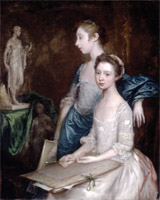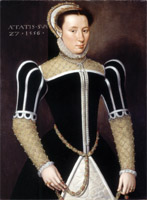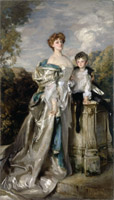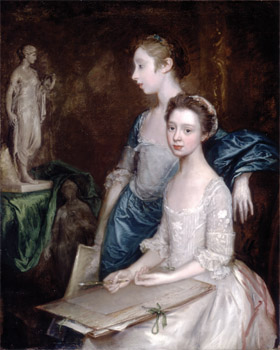September 16, 2009 - January 10, 2010
|
Who among us hasn't wondered at one time or another about the lengths some people go in order to be fashionable? John Garton's Clark University art history seminar look's at the Museum's collection of European painting's to guide us through depictions of female fashion from the sixteenth to the twentieth century, probing the psychological and physiological dimensions of binding fashion (the corset) in the lives of women.
Though precursors to the corset existed as early as four thousand years ago in ancient Crete, the modern corset traces its origins to Renaissance Europe. Bound by Fashion interprets thirteen masterpieces of European painting from the sixteenth to the twentieth century in a self-guided exhibition that tells the story of this unique garment. Some of the greatest paintings in the Worcester Art Museum's collection reveal the psychological and physiological dimensions of binding fashion in the lives of European women. Though corsetry is the primary focus, the exhibition also explores the symbolism of jewelry and the connotative meanings of costume. It is appropriate that paintings from the Worcester Art Museum record this narrative of gender and fashion, as Worcester's own economic history is intimately connected to the corset. In the late nineteenth and early twentieth century, thousands of women worked at the Royal Worcester Corset Factory, producing garments that were shipped all over the world.
“…one cannot have beauty without goodness. Only rarely does an evil soul dwell in a beautiful body, and so outward beauty is a true sign of inner goodness. This loveliness, indeed, is impressed upon the body in various ways as a token by which the soul can be recognized for what it is, just as with trees the beauty of the blossom testifies to the goodness of the fruit.” —Italian humanist Pietro Bembo as quoted in Baldassare Castiglione's Il Cortegiano, 1527
The French word corset in the Renaissance could refer to a man's tight-fitting doublet, body armor, as well as a woman's gown.* Queen Elisabeth preferred to call her stiff corset a “pair of bodies” since the two-part garment could be opened and closed. By the middle of the sixteenth century, a stay, or “busk” of whalebone was usually inserted in the front to reinforce upright posture. This tradition became so ubiquitous that early corsets in France were often called “whalebone bodies” - corps à la baleine. The French Woman at Her Toilette, painted by an artist of the School of Fontainebleau in the 1530s, shows a nude who is not yet wearing her corps à la baleine. However, the white chemise under her arm and the chamber maid retrieving something from a clothing chest in the background suggests the sitter is preparing for high fashion. The Flemish Portrait of a Woman shows the sitter already suited up in her “armor,” an elegant black and gray dress under which she is likely wearing a whalebone corset. Compared with previous centuries, the sixteenth century witnessed a “stiffening up” in representations of women. Gothic paintings of women with rolled shoulders and rounded abdomens gave way to images in which upright posture equaled moral rectitude.
Of course the new mode of fashion seemed to contradict the Renaissance woman's most important duty: motherhood. Antonio Montalvo's Wife and His Son is all the more remarkable as a portrait because it depicts both high fashion and success in bringing about a male heir for the family. One irony of corsetry is that the very means of making women physically attractive also made them less fertile, by putting pressure on the abdomen. Venetians recognized that pregnancies could be at risk, and outlawed the more extreme (and non-adjustable) metal cage corsets in 1547.
The small Spanish-inspired waist was central to seventeenth century fashion. Portrait of a Young Noblewoman by an unknown artist of the School of Madrid shows the extreme formality that could be achieved by wearing a corset and a farthingale, a hooped skirt of suspended, concentric rings. Corsets and tight bodices were often associated with self- and sexual- control as well as social discipline. However, others chose to connect the fashionable allure of such garments with vanity, and so with the devil and whorishness. “The naked bust / framed and trussed / for evil lust!” declared one German pamphlet circulated in the seventeenth century. What these male authors did not see was that fashion is both an indulgence, and a mortification of the flesh.
“How many examples we may see in this sex of contempt of pain! What are women not capable of, what do they fear, as long as they have any hope of improving their beauty?” —French social critic Michel de Montaigne, Essays, Book One, 1580
The sixteenth-century French social critic Michel de Montaigne had taken a more balanced view. He recognized in the absurdity of fashion not the offense against God that his contemporaries saw, but instead something powerful to be revered. Montaigne recognized that the extremes of fashion might actually hold the impulses of a woman's flesh in check, even as it kindled a man's. In his Essays, published in 1580, he mused, “What is the purpose of those great bastions with which our ladies have recently begun to fortify their flanks, but to allure our appetite and to attract us to them by placing us at a distance?” Montaigne recognized women's allegiance to fashion as a strength and martyrdom, bordering on heroic. Indeed, men were held captive by women's fashion, as evidenced by the tender quotation inscribed on a corset busk given to Anne-Marie-Louise d'Orleans, Dutchess de Montpensier in the 1660s.
“How I envy you the happiness that is yours, resting softly on her ivory white breast. Let us divide between us, if you please, this glory. You will be here the day and I shall be there the night.” —amorous lines inscribed on a metal busk (front corset support), given to Anne-Marie-Louise d'Orleans, Dutchess de Montpensier, 1660s
By the eighteenth-century, most children wore corsets. Thomas Gainsborough's Portrait of the Artist's Daughters likely depicts the girls wearing stays to straighten their posture. Flexible stays were even used on toddlers from the age of two, both for boys and girls.
During the 1810s and 1820s some high-minded men of Regency England and Romantic dandies in France wore corsets, though not without controversy. Such sartorial splendor could be worn by the most masculine of men, but the fashion did not catch on and remained something of a rarity for the rest of the century.
“My dear Louisa, you will laugh when I tell you that poor Winifred, who was reduced to be my gentlewoman's gentlewoman, broke two laces in endeavouring to draw my new French stays close. You know that I am naturally small at bottom but now you might literally span me. You never saw such a doll. Then, they are so intolerably wide across the breast, that my arms are absolutely sore with them; and my sides so pinched! - But it is the “ton”; and pride feels no pain.” —Georgiana Cavendish, Duchess of Devonshire's novel The Sylph, 1778
With the Industrial Revolution in the early nineteenth century, corsets became affordable for most of society. But even if women were feeling less of a squeeze financially, there were changes in fashion that left them as tightly bound as ever. In the early 1800s, the ideal feminine beauty resembled a Grecian figure. However, the flowing exterior outline was deceptive, for underneath was hidden a stiff corset that contradicted the natural form. By century's end, new and stronger materials, together with more holes placed immediately opposite one another allowed for the closer cinching of corsets.
In 1900, a corsetiere in Paris, Madame Gaches-Sarraute, designed a new corset with a straight-fronted busk which extended the bust-line down over the abdomen, but did not curve into the waist like the spoon busk of the nineteenth century. However, soon after its conception, this new “health corset” was exaggerated by tight-lacing to return to the previously desired small waistline. This resulted in the ‘S’ curve corset seen in Lady Warwick and Her Son. This corset reached its peak in 1904-1905 after which a straighter line corset came into fashion.
Worcester Bound
One of the backbones of Worcester's industrial economy was The Royal Worcester Corset Factory founded by David Hale Fanning. Established in 1861 as a hoop skirt factory, the business reoriented to corsets, and by 1912 had become a sprawling factory on Wyman and Hollis Streets, with an extension on Grand Street.
The Royal Worcester Corset Factory gained national acclaim during these years and touted itself as the “factory of America” for its modern amenities and progressive treatment of workers. It became an international supplier, shipping corsets to such places as Cape Town, Stockholm, Shanghai, and Buenos Aires. In its publicity, the Royal Worcester Corset Factory claimed to be the largest corset manufacturer in the world. It was also able to boast of being the largest employer of female workers in the country. Women counted for about 90% of their work force. However, since this was still the turn of the century and the suffrage movement was underway, women's salaries were often only about 40% of their male counterparts.
The Royal Worcester Corset Company offered a variety of styles and sizes in an effort to match the right corset with the right physique. As one advertisement lamented, “It is not to be wondered at that many women today can trace present ill health to the wearing of corsets that were not in any way adapted to their forms or constitutions.” The company produced three brand names: “Royal Worcester,” “Bon Ton,” and “Adjusto” (for ‘fleshy’ women). Prices ranged from $1-3 for the Royal Worcester corset and $3-5 for Adjusto to $3-15 for the Bon Ton corsets. In 2009, those prices would roughly equal $24.41 to $366.16.
Although Royal Worcester Corset Company closed its doors and sold its factory in 1949, it is remembered as a thriving place in the commercial life of Worcester. The home of its founder, David Hale Fanning, was eventually acquired by Clark University and is now the site of Wright Hall dormitory. Today, the once bustling corset factory is occupied by Royal Worcester Apartments between Grand and Wyman Streets.
The Corset's End
During World War I, corsets were still deemed essential, even as some women participated in factory work to support the war effort and other suffragists refused to wear them. The coveted tubular shape of women in the 1920s and 1930s led to corsetry that came to rely more and more on new, elastic material. World War II brought about a shortage of corsetry materials, a mending of older garments, and a giving up of corsets by more and more women. Christian Dior's fashions around 1947, however, brought back tight-lacing in the form of short (seven to eight-inch long) corsets only for the waist. However, this was a short-lived trend only for the very wealthy. By the 1950s, fashion dictated that a woman's breasts were more attractive separated than pressed down together by a corset. The brassiere emerged supreme, and with it a separate, elastic garment to flatten the lower figure: the girdle.
Download the Gallery Guide
Bound by Fashion promotional video
About the Exhibition
Collaboration between Clark University and the Worcester Art Museum made this exhibition possible. Clark University students chose the theme, selected the works, and wrote the special labels and brochure. Funding was provided in part by the Higgins School of Humanities, Clark University.
* Several of the quotes and historical examples in this brochure are discussed in the magisterial study of Valerie Steele, The Corset: A Cultural History (New Haven: Yale University Press, 2001).
Related Events
Tour of the Month: Bound by Fashion
Wednesday, September 16, 2pm
Saturday, September 19, 2pm
All tours meet at the Lancaster Street entrance lobby. Free with Museum admission.
Who among us hasn't wondered at one time or another about the lengths some people go in order to be fashionable? John Garton's Clark University art history seminar looks at the Museum's collection of European painting's to guide us through depictions of female fashion from the sixteenth to the twentieth century, probing the psychological and physiological dimensions of binding fashion (the corset) in the lives of women.
Worcester Waists
Sunday, October 11, 2pm
Conference Room. Free with Museum Admission. Free for WAM Members and Preservation Worcester Members.
Join Worcester Art Museum staff member & Preservation Worcester Docent Kelli Blank in this fascinating discussion on the Corset Industry in Worcester, from 1860-1940. Held in conjunction with the exhibition Bound by Fashion: The Corset in European Art.
Select Images from the Exhibition
 |
 |
 |
 |
 |
 |


 Sign up for WAM eNews
Sign up for WAM eNews